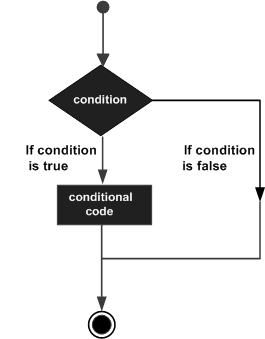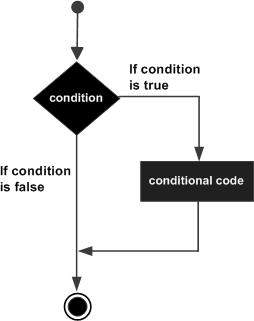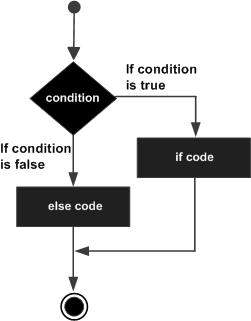Flow control in C programming
Flow control structures require the programmer to determine one or more conditions to evaluate and test by the program, along with the commands to be executed if the condition is determined to be correct, or other commands are executed. if the condition is wrong.
Below is a common pattern of a common flow control structure in a programming language.

The C programming language assumes that all values other than zero or not null are true , if there are zero or null values, it is false .
Language C provides the following types of flow control structures.
Command DescriptionIf statement
An if statement consists of a logical expression followed by one or more other commands.If . else statement
An if statement can be followed by an else statement (optional: yes or no), which can be executed when the logical expression is false.If command
You can use if or else if statements inside if or else if else statements .Switch command
A switch command allows checking the condition of a variable before executing commands.Command switch
You can use a switch command inside another switch command.Conditional operator? : in C
We discussed conditional operators? : in the previous chapter that can be used to change the position for the if . else statement . It has the following general pattern:
bieuthuc1 ? bieuthuc2 : bieuthuc3 ;
In which Exp1, Exp2 and Exp3 are expressions. Notice the use and setting of the colon.
The value of the expression Exp1 before the sign? with true value, Exp2 is executed, and its value is the value of the expression. If Exp1 is false , Exp3 is executed and its value is the value of the expression.
If statement in C
An if statement in Language C contains a logical expression followed by one or more commands.
Syntax:
The following is the syntax of an if statement in Language C:
if ( bieu_thuc_boolean ) { /* cac lenh se duoc thuc thi neu bieu thuc boolean la true */ } If the logical expression is evaluated as true , then the code block inside the if statement will be executed. If the logical expression is evaluated as false , then the command immediately after the if statement will be executed.
The C language assumes that any non-zero and non-null values are true , and if it is zero or null , then it is assumed to be false.
Diagram:

For example:
#include int main () { /* phan dinh nghia bien cuc bo */ int a = 15 ; /* kiem tra dieu kien voi lenh if */ if ( a < 20 ) { /* neu dieu kien la true thi in dong sau */ printf ( "a la nho hon 20n" ); } printf ( "Gia tri cua a la: %dn" , a ); printf ( "===========================n" ); printf ( "QTM chuc cac ban hoc tot! n" ); return 0 ; } Compiling and executing the above C program will produce the following results:

If . else command in C
An if statement can be followed by an optional else command, which executes when the logical expression is false.
Syntax:
Syntax of an if . else command in Language C is:
if ( bieu_thuc_boolean ) { /* cac lenh se duoc thuc thi neu bieu thuc boolean la true */ } else { /* cac lenh se duoc thuc thi neu bieu thuc boolean la false */ } If the logical expression is evaluated to be true, then the if block will be executed, otherwise the else block will be executed.
The C language assumes that any non-zero and non-null values are true, and if it is zero or null, then it is assumed to be false.
Diagram:

For example:
#include int main () { /* phan dinh nghia bien cuc bo */ int a = 36 ; /* kiem tra dieu kien */ if ( a < 20 ) { /* neu dieu kien la true thi in dong sau */ printf ( "a la nho hon 20n" ); } else { /* neu dieu kien la false thi in dong sau */ printf ( "a khong nho hon 20n" ); } printf ( "Gia tri cua a la: %dn" , a ); printf ( "===========================n" ); printf ( "QTM chuc cac ban hoc tot! n" ); return 0 ; } Compiling and executing the above C program will produce the following results:

If nested statement in C
It is valid to nest if-else statements in Language C, which means you can use an if or else statement inside another if or else statement.
Syntax:
Syntax to nest if statements :
if ( bieu_thuc_boolean 1 ) { /* Thuc thi khi bieu thuc boolean 1 la true */ if ( bieu_thuc_boolean 2 ) { /* Thuc thi khi bieu thuc boolean 2 la true */ } } You can nested else if . else in the same way as if you had inserted the if statement .
For example:
#include int main () { /* phan dinh nghia bien cuc bo */ int a = 667 ; int b = 7028 ; /* kiem tra dieu kien */ if ( a == 667 ) { /* neu dieu kien la true thi tiep tuc kiem tra dieu kien sau */ if ( b == 7028 ) { /* neu dieu kien la true thi in dong sau */ printf ( "Gia tri cua a la 667 va cua b la 7028n" ); } } printf ( "Gia tri chinh xac cua a la: %dn" , a ); printf ( "Gia tri chinh xac cua b la: %dn" , b ); printf ( "===========================n" ); printf ( "QTM chuc cac ban hoc tot! n" ); return 0 ; } Compiling and executing the above C program will produce the following results:

Switch command in C
A switch command for a variable is checked equally in the list of values. Each value is called a case - the case and the variable passed are checked for each switch case .
Syntax:
The syntax of switch command in Language C is as follows:
switch ( bieu_thuc ){ case bieu_thuc_hang : cac_lenh ; break ; /* tuy y */ case bieu_thuc_hang : cac_lenh ; break ; /* tuy y */ /* ban co the co bao nhieu lenh case tuy y */ default : /* tuy y */ cac_lenh ; } The following rules apply to a switch command:
The expression is used in a switch command that must be of type integer or enumeration, or one of the class types in which the class has a single function that converts to an integer or enumeration type.
You can have any number of case commands in a switch. Each case is followed by the value to be compared and a colon.
bieu_thuc_hang for a case must be the same data type as the variable in the switch, and it must be constant.
When the variable passed is balanced with a case, the following case statement will execute until a break statement is encountered.
When the break command is encountered, the switch ends, and the control line jumps to the next command line of the switch.
Not every case should contain a break statement. If no break statement appears, the control line will not reach the next case until a break statement is encountered.
A switch command may have an optional default (default) case, which must appear at the end of the switch. This default case can be used to perform a task when there is no true case. In this default case, there is no break command required.
Diagram:

For example:
#include int main () { /* phan dinh nghia bien cuc bo */ char hocluc = 'B' ; switch ( hocluc ) { case 'A' : printf ( "Xuat sac!n" ); break ; case 'B' : printf ( "Gioin" ); break ; case 'C' : printf ( "Khan" ); break ; case 'D' : printf ( "Trung Binhn" ); break ; case 'F' : printf ( "Ban phai hoc lai !!!n" ); break ; default : printf ( "Du lieu nhap khong hop len" ); } printf ( "Hoc luc cua sinh vien la %cn" , hocluc ); printf ( "===========================n" ); printf ( "QTM chuc cac ban hoc tot! n" ); return 0 ; } Compiling and executing the above C program will produce the following results:

Insert switch commands in C
It is possible to have a switch command as part of the command sequence in a switch command on the outer ring. Even if the case constant inside and outside the switch command contains normal values, no conflict will occur here.
Syntax:
The syntax to insert switch commands is as follows:
switch ( ch1 ) { case 'A' : printf ( "A la mot phan cua lenh switch ben ngoai" ); switch ( ch2 ) { case 'A' : printf ( "A la mot phan cua lenh switch ben trong" ); break ; case 'B' : /* phan code tuong tu khac */ } break ; case 'B' : /* phan code tuong tu khac */ } For example:
#include int main () { /* phan dinh nghia bien cuc bo */ int a = 35 ; int b = 26 ; switch ( a ) { case 35 : printf ( "Day la mot phan cua lenh switch ben ngoain" , a ); switch ( b ) { case 26 : printf ( "Day la mot phan cua lenh switch ben trongn" , a ); } } printf ( "Gia tri chinh xac cua a la : %dn" , a ); printf ( "Gia tri chinh xac cua b la : %dn" , b ); printf ( "===========================n" ); printf ( "QTM chuc cac ban hoc tot! n" ); return 0 ; } Compiling and executing the above C program will produce the following results:

According to Tutorialspoint
Previous article: Operator in programming C
Next lesson: Loop in programming C
You should read it
- Set of multiple choice questions about programming with P12
- Beginners of computer programming need to focus on what?
- Set of multiple choice questions for programming with P15 prize
- Set of multiple choice questions about programming with P7 prize
- Set of multiple-choice questions on award-winning programming P5
- Set of multiple choice questions about programming with P6
 Loop in programming C
Loop in programming C Function in programming C
Function in programming C Scope rules in programming C
Scope rules in programming C Array in Language C
Array in Language C Cursor in C
Cursor in C String in C
String in C